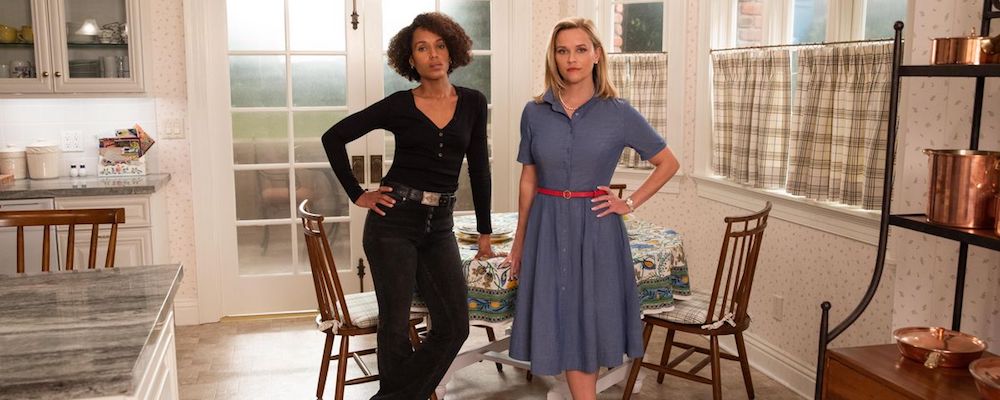Hulu’s ‘Little Fires Everywhere’ Finds the Void Between Race and Class in America
Alci Rengifo
“Little Fires Everywhere” is a familiar storytelling ground, another trip into American suburbia, where the privileged are clueless and the free spirited must open their eyes somehow. For this journey into the world of pristine laws, Hulu has adapted the bestseller by Celeste Ng, emphasizing its ideas with some strong performances and lean writing. It’s a well-mounted production, even if we have been to this neighborhood before.
It is 1997 and into an area of apparent order and professionalism arrive Mia (Kerry Washington), an artist living day by day while moving around with daughter Pearl (Lexi Underwood). They come to the attention of Elena Richardson (Reese Witherspoon), a local elite who cuts Mia a deal on staying in her rental home. In exchange Mia also becomes a part-time housekeeper for Elena and her family which includes lawyer husband Bill (Joshua Jackson), pretentious daughter Lexie (Jade Pettyjohn), the more rebellious Izzy (Megan Stott) and easy-going Moody (Gavin Lewis). As Pearl starts attending high school and grows closer to the Richardson kids, Mia begins to represent the class and racial gaps many suburbanites are oblivious to. She lives out of vocation, smokes weed while doing her art, sleeps casually with other men, while Elena represents the values of professional, disciplined suburbia where status depends on material worth. Of course she still promotes humanist, progressive values. But when Mia discovers that a co-worker’s lost infant might now be the adopted child of one of Elena’s society friends, it threatens to blow apart differences usually subdued.
Witherspoon produces along with Ng this adaptation which alters some of the novel’s original elements to better fit more of what’s common in TV suburbia. For example in the book Mia is white, here she’s made into an African American character which allows the series to become about not only class, but how class also links to race in American society. Elena is one of those successful liberals who can’t read a room and tries so hard to make everyone know she’s not racist. This leads to awkward moments, like when she introduces Pearl to Lexie’s black boyfriend Brian (Stevonte Hart) and giddily exclaims, “you probably have a lot in common!” It’s in capturing moments like this “Little Fires Everywhere” works best, by sharply drawing personalities defined by their station in life. Many moments brim with a satirical authenticity. The neighborhood women form a book club and a discussion descends into a heated debate over the value of a vagina and why it makes sense to aspire to motherhood. Bill’s fellow (married) white collar buddies get envious at baby showers that Elena lets someone as attractive as Mia around the house. The writing and directing team capture the quirks and contradictions of orderly upper middle class life. For Moody it’s almost an astounding revelation to discover that Mia smokes while painting, because in his world such things are not seen as responsible. Elena will destroy a Christmas photo session simply because Izzy refuses to wear a certain pair of sneakers.
If much of this sounds familiar it’s because “Little Fires Everywhere” is not exactly groundbreaking. It’s vision of suburbia and use of minority characters as metaphors is similar to films like “Little Children” and other shows like “Here and Now.” None of what it has to say about class in America is new. High school is a social jungle where Pearl begins to feel more at home with the independent-minded rebels, but it takes her a while to realize she’s being used by Lexie (who steals Pearl’s own story for her college admission essay). The teenagers all feel authentic in their clumsy experiments with sex, in the cliques they form between the “cool” and “weird” kids. Izzy provides a different story angle because she’s gay, which in the ‘90s was an extremely sensitive existence in school. She has pinned in her locker the famous Time cover where Ellen DeGeneres came out. Inevitably Izzy also provides the show’s central, opening mystery, when she becomes the suspect of a major house fire.
When Mia tries to help a co-worker, Bebe (Liz Huang) recover her baby, left at a public space where it was then found and given up for adoption to a family in Elena’s neighborhood, the show expertly generates tension. But it’s mainly to again make points we’ve seen countless times in other shows. Elena is there to remind us that suburbanites are materialist control freaks, puffed up by their own privilege and fancy job titles, while Mia is the sexually free artist who has her own, dark secrets but represents everything oppressive Elena is not. Yet it’s all very well acted by a superb cast that makes the material engaging. Just because it’s familiar doesn’t mean it loses relevancy or purpose. Reese Witherspoon, who has been doing fantastic TV work recently in shows like “Big Little Lies” and “The Morning Show,” turns Elena into a pitifully vicious character. Kerry Washington’s Mia has both presence and vulnerability. She perfectly captures a personality confused by this neighborhood’s obsession with the mundane.
“Little Fires Everywhere” takes us on yet another drive down those comfortably closed off areas of America that define “good schools” and success, exposing that beneath it all everyone is still human and tragically flawed. We’ve been here before, but because it’s well-made we don’t mind passing through.
“Little Fires Everywhere” premieres its first three episodes March 18 with new episodes streaming every Wednesday on Hulu.

